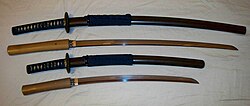脇差
Japanese

| Kanji in this term | |
|---|---|
| 脇 | 差 |
| わき Grade: S |
さ(し) > ざ(し) Grade: 4 |
| kun'yomi | |
Etymology
Compound of 脇 (waki, “armpit, side of the torso”) + 差 (sashi, the 連用形 (ren'yōkei, “continuative or stem form”) of verb 差す sasu “to insert, to stick into”), from the way the wakizashi would be stuck at one's side through the 帯 (obi, “belt or sash”).[1] The sashi changes to zashi as an instance of rendaku (連濁).
Pronunciation
Lua error in Module:ja-pron at line 88: Parameter "yomi" is not used by this template.
Noun
- (weaponry) a traditional Japanese shortsword, often used as a secondary weapon to a katana
Coordinate terms
- 刀 (katana): traditional Japanese single-bladed curved sword
- 短刀 (tantō): traditional Japanese shortsword or dagger (30cm and shorter)
- 大小 (daishō): “big and small”: the katana and wakizashi as a set
See also
References
- ^ Shōgaku Tosho (1988) 国語大辞典(新装版) [Unabridged Dictionary of Japanese (Revised Edition)] (in Japanese), Tōkyō: Shogakukan, →ISBN
Categories:
- Japanese terms spelled with 脇 read as わき
- Japanese terms spelled with 差 read as さ
- Japanese terms read with kun'yomi
- Japanese compound terms
- Japanese terms with rendaku
- Japanese lemmas
- Japanese nouns
- Japanese terms spelled with secondary school kanji
- Japanese terms spelled with fourth grade kanji
- Japanese terms written with two Han script characters
- ja:Weapons
